Editor’s Note: This article first appeared in the July 2016 edition of TTAC’s Heroes Against Cancer member newsletter
Juicing fresh greens is a fantastic way to boost your antioxidant levels. Greens are loaded with minerals, enzymes, and vitamins to support your body’s natural healing abilities… whether it be from cancer or other chronic disease.
With juicing the fiber is removed from fruits and vegetables. This allows the digestive tract to more readily absorb nutrients into the bloodstream for uptake into organs and cells. This doesn’t mean the fiber needs to go to waste. You may wish to reserve some of the pulp separated during juicing and add it into foods such salads, soups, or stews at a later time.
The nutritional content of juice is highest immediately following juicing. As time passes, air and light degrade the nutrients and the juice loses some of its nutritional value. Ideally you should use the highest quality ingredients possible such as organic fruits and vegetables. You should also always serve and store juice in glass versus a plastic container. This avoids hazardous xenoestrogenic chemicals (chemicals that mimic estrogen) which can interact with the hormones in your body and cause damaging effects over time.
What Should You Juice?
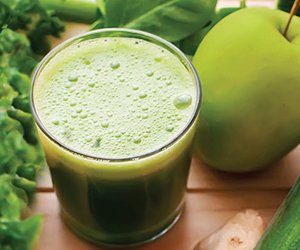
Juicing fresh greens is a fantastic way to boost your antioxidant levels
Some of my favorite things to juice include green apples, cucumbers, celery, and lemons and limes. I combine these with powerful detoxifying herbs such as cilantro and parsley, and antioxidant rich ingredients including dandelion, bok choy, kale, ginger, and spinach.
In order to keep sugar content low, it is best to keep sweeter fruits and vegetables to a minimum. For example, I do not add more than one small apple or at the very most five carrots into a single serving of fresh juice. When juicing high sugar fruits and vegetables (i.e. beets and carrots), combine them with foods containing citric acid. Sources of citric acid such as lemon or lime reduce the glycemic load and thereby lower the inflammatory effects of sugar from the fruit.
The Best Fruits for Green Juice
The following fruits are packed with nutrients and low in sugar, and are excellent choices for juicing.
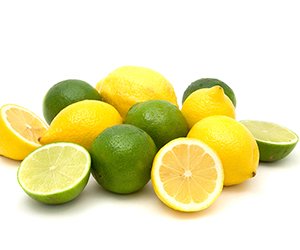
Lemons and limes contain citric acid which helps to balance fruits and veggies with a higher sugar content
Lemons and Limes: Lemon and lime are powerful citrus fruits loaded with vitamin C and vitamin P, also known as citrus bioflavonoids. Vitamin P has been shown to increase the antioxidant abilities of vitamin C, and together they have a synergistic health benefit.
Bioflavonoids also increase blood flow necessary for oxygenating cells and improving capillary permeability essential to maintaining healthy blood pressure. Antioxidants vitamin C and vitamin P minimize inflammation, edema, and venous backup (blood backing up into the vein which can cause conditions such as varicose veins).
Lemons and limes are also natural antiseptics as the citric acid removes hazardous microbes in the body. Combined, the vitamins, citric acid, and electrolytes in these sour citrus fruits alkalize the body.
Green Apples: Traditionally more sour than a red apple, green apples also have reduced sugar content and more acetic acid. Acetic acid is the major component in apple cider vinegar and is another antiseptic tool which stimulates function of the gall bladder, liver, stomach, and intestines. Aside from having an alkalizing effect on the body, green apples contain procydin. Procydin is an antioxidant with cancer fighting properties.
Hydrating Vegetables to Include in Your Green Juice
Vegetables are loaded with water and electrolytes and most are low in sugar. Some of these vegetables produce a high yield of juice and should be a staple to fresh juicing. Some of the best vegetables to juice are cucumbers, celery, and bok choy.
Cucumbers: Cucumbers are loaded with hydrating fluids for the skin, joints, and tissue. They are rich with silica, which is an essential mineral for healthy connective tissue such as muscles, bones, and skin. Cucumbers are also loaded with ionic potassium, vitamin C, and magnesium which produce a strong alkalizing effect on the body.
Celery: Celery is a good source of folate, calcium, and magnesium, along with vitamins A, C, and K. Celery is high in water, electrolytes such as potassium and sodium, and contains dihydrostilbenoids. This type of phenol is an antioxidant that is comparable to the resveratrol found in grape skins or wine. Celery is great for juicing and helps to stabilize body pH.
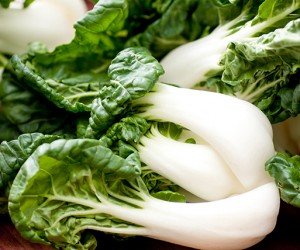
Bok choy is a type of Chinese cabbage that doesn’t look like cabbage. Baby bok choi has a milder taste than many other cruciferous vegetables
Bok Choy: These water-rich cruciferous vegetables contain more than 70 phenolic antioxidants and electrolytes. Hydroxycinnamic acid is one of the most potent phenolic compounds found in bok choy and is referred to as “chain breaking” antioxidants as a result of its free radical scavenging strengths. For this reason, bok choy is being studied for its cancer prevention properties.
Dark Green Leafy Vegetables
Chlorophyll is one of the greatest life-giving components on the planet. This compound gives foods their green color and is a major component of the photosynthetic process which converts the sun’s energy into chemical energy.
A major indicator of the health attributes of any plant based food is the chlorophyll content. Foods rich in chlorophyll are deep green and are highly capable of building new blood cells and purifying the body from the toxic effects resulting from cancer and radiation. Chlorophyl is also extraordinarily useful in wound healing, detoxification, intestinal regularity, and deodorization of the body.
Some of the best chlorophyll-rich dark greens you can include in your green juice are spinach, collard greens, parsley, and kale.
Spinach: Spinach is a powerful source of chlorophyll and glycolycerolipids which protect the digestive tract from inflammation and damage. Glycoclycerolipids are the major fatty acids which make up cell membranes of light-sensitive organs in plants containing chlorophyll. They also have strong immune boosting and cancer prevention properties. Spinach is an important source of nutrients such as copper, zinc, and selenium which stimulate immunity.
Collards: These fan-like greens are a nutritional superstar. Collards are extremely rich in vitamins A, B2, B6, C, K, and are packed with magnesium and folate. Collard greens also contain a sulfur compound known as isothiocyanates which protect the p53 gene considered to be the guardian of the genome and critical at normal cell cycle regulation. When the p53 becomes mutated, the normal cell cycle fails and cancerous developments form.
Kale: Kale contains powerful nutrients like glucosinolates and methyl cysteine sulfoxides. These detoxifying nutrients activate enzymes in the liver which play a critical role in removing the carcinogenic load on the body. Sulforaphane is an example of a type of glucosinolate and is formed when kale is masticated (chewed up) or ground. Sulforaphane has been studied for its ability to change the genetic expression of the liver allowing it to more effectively use its detoxification enzymes.
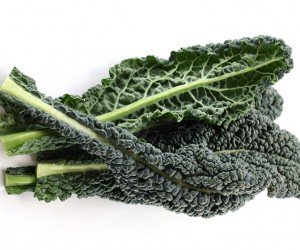
Lacianto kale (also known as black kale or Italian kale) is a flat kale that works better for juicing than curly kale
Lacianto kale contains more water and has a better flavor in my opinion than curly kale. Curly kale is more difficult to juice and I recommend saving it for other uses such as making kale chips.
Watercress: Watercress is a rapidly growing aquatic or semi-aquatic perennial and one of the oldest known leaf vegetables eaten by humans. Vitamins and minerals like B6, magnesium, and folate found in watercress are highly available to the body and assist the digestive tract. Watercress is also high in chlorophyll and carotenoid antioxidants.
Cereal Juices: Examples of cereal juices include wheatgrass, barley grass, oat grass, and rye grass. These grasses do not contain grain and are gluten free, low in carbohydrates, and are nutrient rich.
These greens are best when juiced alone without added vegetables. (Note: not every juicer can handle grasses, so be sure to consult your owner’s manual before putting them through your juicer.)
Cows can live an incredibly healthy and long life consuming cereal grasses alone. Humans, however, cannot digest these tough fibers and juicing provides a great avenue for consuming these inedible but antioxidant packed grasses. Cereal grasses contain the blood detoxifying nutrient chlorophyll as well as methylating agents such as magnesium, folate, and vitamins B2 and B6. Cereal grasses are also rich in carotenoid antioxidants which can help prevent some forms of cancer and heal damage from cancer treatments.
Get an Added Health Boost From Bitter Herbs
Bitter herbs are not popular in western society and are not regularly used. Although they may not have a pleasant flavor, their nutrient content and health benefits are outstanding. Bitter herbs boost digestive enzymes and improve liver and gallbladder function.
A process known as “bitter reflex” occurs when the bitter flavor is recognized by the tongue, signaling a series of reactions in the neuroendocrine system. The hormone gastrin within the stomach increases the output of hydrochloric acid which aids in digestion. A continued reflex occurs when the liver and gallbladder secrete bile and pancreatic enzymes. Studies indicate that the bitter reflex improves the structure and capabilities of all digestive organs.
A saying which describes the healing potential of these herbs is “bitter is good for the liver.” They cleanse the blood, digestive system, urinary tract, and kidneys.
Two major categories divide bitter herbs. One is cholagogues which improves the flow of bile. Cholagogues include parsley, dandelion, burdock root, artichoke, ginger, and goldenseal. The second category is known as hepatoprotectants. Hepatoprotectants heal and protect the liver from toxic exposure. Examples of these bitter herbs are turmeric and milk thistle. Try to include one or more bitter herbs from each category into your juicing regimen for optimal detoxification.
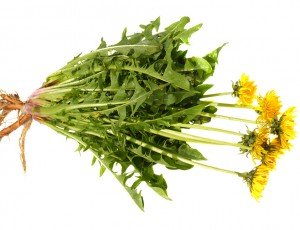
Fresh young dandelion leaves (from yards that have not been sprayed with pesticides) are a wonderful free source of bitter herbs
Dandelion: Dandelion greens are rich in vitamin C and bioflavonoids. They are also very high in absorbable methylating agents such as vitamin B2, B6, and folate. This herb is packed with minerals such as iron, potassium, and zinc, which help to release excess fluid out of the body, detoxifying the kidneys and liver. Dandelion greens aid in digestion, relieve swelling and inflammation, and have been used to treat jaundice, edema, gout, acne, and eczema.
Parsley: Highly abundant in chlorophyll, parsley contains three times the amount of vitamin C found in an orange. Vitamin C is vital for a healthy immune system and youthful skin and joints. Parsley also contains carotenoid antioxidants such as lutein and zeaxanthin which boost eye function and enable the body to heal damage from UV and radiation.
Cilantro (Coriander): Cilantro is also known by other names including dhania, coriander leaves, Chinese parsley, and Mexican parsley. It contains a variety of phytonutrients and chlorophyll and is a strong heavy metal detoxifier. Extremely beneficial for blood, liver and kidney purification, include cilantro in your fresh green juice to pull heavy metals such as mercury, aluminum, and nickel out of the body.
Ginger: Ginger is known for its ability to reduce intestinal gas, smooth the intestinal tract, and stimulate gut motility (which is important for avoiding constipation). Ginger has also been shown to limit fever related nausea, motion sickness, and reduce the feeling of morning sickness, as well as aid in the production of bile beneficial for the digestion of fat.
Turmeric: Turmeric is an orange tuberous root traditionally used for centuries in Ayurvedic and Chinese medicine as well as in Asian and Indian cooking. One of the most powerful active compounds in turmeric is curcumin. Curcumin exhibits strong anti-inflammatory properties and has also been studied for its ability to detoxify the liver and increase glutathione (the “master antioxidant”) concentration.
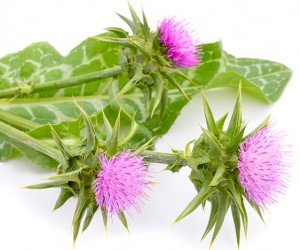
Milk thistle grows wild in many places and can often be foraged for free. The leaves can be juiced (handle carefully and you may wish to trim off the spiky parts first). The seeds can be dried and sprinkled on salads
Milk Thistle: Used by medical herbalists before the turn of the 20th century, milk thistle was used to treat varicose veins as well as liver, kidney, and spleen disorders. Today milk thistle is commonly used to boost liver, kidney, and gastrointestinal system function. Milk thistle has been shown to improve numerous health issues including psoriasis, jaundice, poor circulation, and menstrual complications.
A Few Juicing Combinations to Try
I enjoy combining low-glycemic fruits, hydrating vegetables, dark greens, and bitter herbs for a powerful super green juice. Some popular combinations that I frequently juice include the following:
Lemon/Ginger:
- 1 lemon, diced
- 1 small Granny Smith apple, diced
- 2 handfuls of baby spinach
- 1 handful of dandelion greens
- 1 handful of cilantro
- 1 cucumber, diced
- 1 inch of ginger root
Lime/Ginger:
- 1 small Granny Smith apple, diced
- 1 lime, diced
- 2 handfuls of watercress
- 1 handful of dill weed
- 1 handful of parsley
- 1 stalk celery
- 1 inch of ginger root
Super Detox:
- 1 small Granny Smith apple, diced
- 1 lemon OR lime
- 1 stalk bok choy
- 1 cucumber, diced
- 2 handfuls of spinach
- 1 handful cilantro
- 1 inch of ginger root
- 1 inch of turmeric root
What are some of your favorite green juice recipes? There are countless combinations which you can create depending on what fresh ingredients are available to you.
Local farmers markets are a great resource for fresh produce, especially in the summer months and into the fall. If you can’t find some of the vegetables and herbs mentioned, it is always best to substitute any fresh, organic items readily available to you.
Remember, a juicing recipe is merely a suggestion. Feel free to be creative and discover what juices make you feel best!
This article first appeared in the July 2016 edition of TTAC’s Heroes Against Cancer newsletter. Each month in Heroes Against Cancer we share the best ways you can use to get and stay healthy – including delicious recipes and the best in supplements, herbs and spices. Find out more about our member newsletter here.
Article Summary
Juicing removes the fiber from fruits and vegetables allowing the digestive tract to more readily absorb nutrients into the bloodstream for uptake into organs and cells.
The nutritional content of juice is highest immediately following juicing.
Juicing fresh greens is a fantastic way to boost your antioxidant levels.
When juicing high sugar fruits and vegetables (i.e. beets and carrots), combine them with foods containing citric acid.
The best fruits for green juice include:
- Lemons and limes
- Green apples
Hydrating vegetables to include in your green juice:
- Cucumbers
- Celery
- Bok Choy
- Spinach
- Collards
- Kale
- Watercress
- Cereal Juices
Try to include one or more these bitter herbs into your juicing regimen for optimal detoxification:
- Dandelion
- Parsley
- Cilantro
- Ginger
- Turmeric
- Milk Thistle










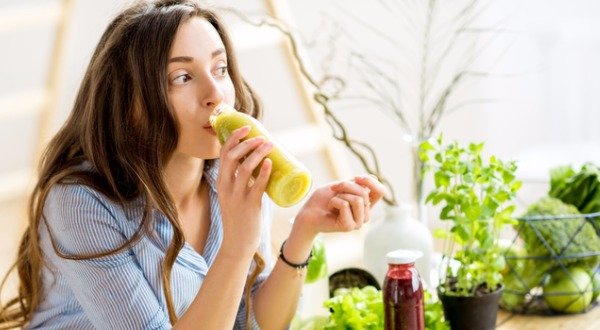








Great article thanks! I wish purslane might have been included. Though I have never juiced it, I propagate nice patches of it and consume it daily in soups and or sauteed. It is very succulent and is loaded with Omega 3 fatty acids. I would love to try it juiced … if I had a juicer. 😉
Juicers turn up frequently in second hand stores – often barely used. I once found a brand new Champion masticating juicer for $15! (maybe they tried it once…maybe). I now have one at home and one at work. Cheaper centrifugal juicers are more common but equally inexpensive. It’s worth stopping in ’till one appears.
THANKYOU SO MUCH FOR THIS ARTICAL I AM IN THE MIDST OF A JUICING AND SMOOTHY CHANGE OF LIFE AND HABITS AND AM VERY GRATEFUL FOR YOUR WONDERFUL COMMITMENT TO EXPOSING THE INDUSTRIES THAT HAVE DONE SO MUCH HARM
MAY YOU BE BLESSED IN EVERYTHING YOU DO
Marlene Ward
If you are juicing, why would you dice the fruit or vegetables? Wouldn’t you just cut to fit in your juicer?
The lemons and limes – are they peeled first or are juiced complete with the skin on?
Good question. I was wandering the same thing. Hopefully someone from TTAC will give guidance with this. I’m new to juicing myself.
Hi Mark,
Here are some great articles about juicing!
https://thetruthaboutcancer.com/juicing-vs-blending/
https://thetruthaboutcancer.com/the-juice-lady-on-juicing-for-health-benefits-video/
https://thetruthaboutcancer.com/juicing-video/
https://thetruthaboutcancer.com/the-juice-lady-routine-video/
What a fantastic article. Simple and not at all overwhelming like some articles can be. Very practical and certainly easily doable. Thanks again.
Quick question. Is dandilion straight from the garden ok to consume?
I believe so, as long as they haven’t been treated with weed killer and any use of weed killer has been used nearby.
thank you for that, you are a star for helping all, much love.
Thanks for the info it was a great help
I have the same questions as Robin and Leonie. Please reply. Important
I have a juicer and Vitamix. Can the greens and citrus also be used in the Vitamix?
It’s a powerful blender.
LOVE the post, so essential to address juicing issues as most contain too much sugar. Thank you so much, will begin to juice with your suggestions. Or use the blender upon reply.
What are the best Juicers (machines) to use?
Do you peel the lemons and limes?
Why use juicing machines.Just throw all the ingredients into a Vitamix blender? It is an anazing machine. Also throw broccoli in the mix
I tend to prefer to eat the greens as vegetables because when you are juicing green vegetables, you are getting rid of nutrients and essential vitamins.